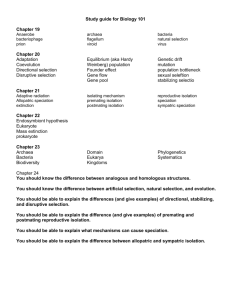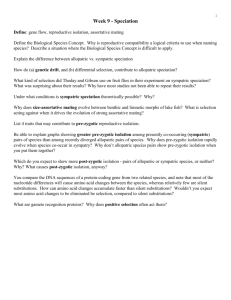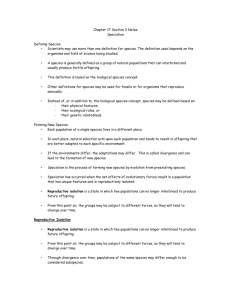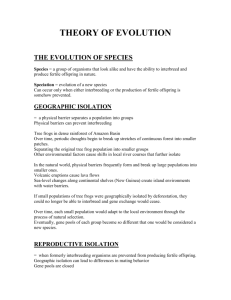Answers to Mastering Concepts Questions
advertisement
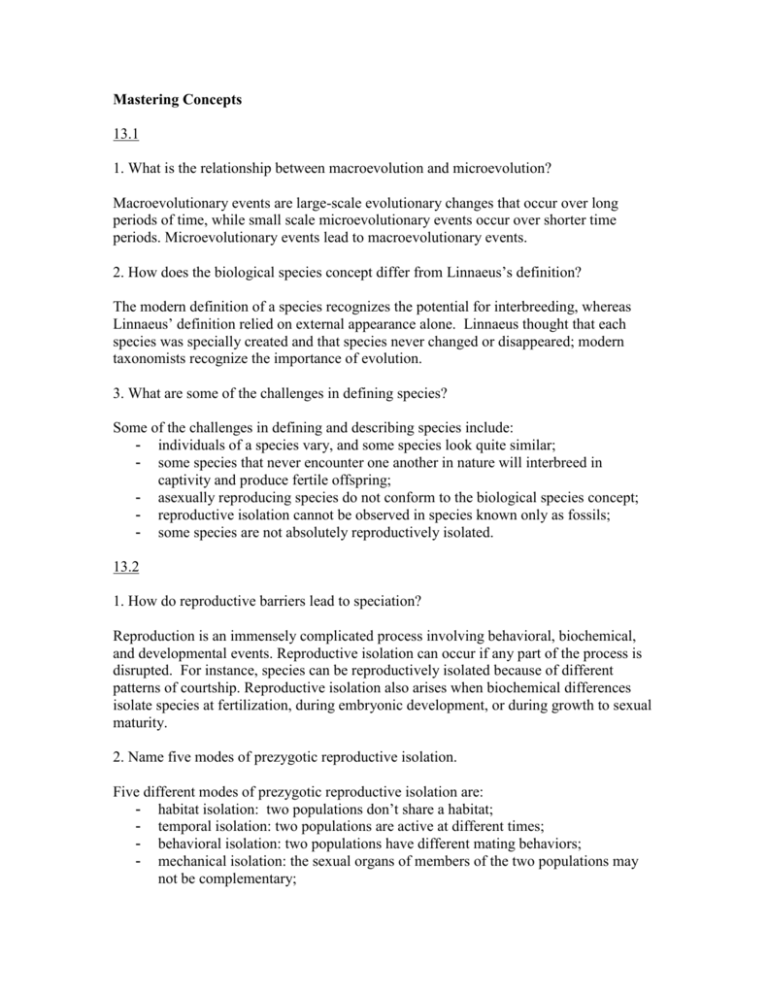
Mastering Concepts 13.1 1. What is the relationship between macroevolution and microevolution? Macroevolutionary events are large-scale evolutionary changes that occur over long periods of time, while small scale microevolutionary events occur over shorter time periods. Microevolutionary events lead to macroevolutionary events. 2. How does the biological species concept differ from Linnaeus’s definition? The modern definition of a species recognizes the potential for interbreeding, whereas Linnaeus’ definition relied on external appearance alone. Linnaeus thought that each species was specially created and that species never changed or disappeared; modern taxonomists recognize the importance of evolution. 3. What are some of the challenges in defining species? Some of the challenges in defining and describing species include: - individuals of a species vary, and some species look quite similar; - some species that never encounter one another in nature will interbreed in captivity and produce fertile offspring; - asexually reproducing species do not conform to the biological species concept; - reproductive isolation cannot be observed in species known only as fossils; - some species are not absolutely reproductively isolated. 13.2 1. How do reproductive barriers lead to speciation? Reproduction is an immensely complicated process involving behavioral, biochemical, and developmental events. Reproductive isolation can occur if any part of the process is disrupted. For instance, species can be reproductively isolated because of different patterns of courtship. Reproductive isolation also arises when biochemical differences isolate species at fertilization, during embryonic development, or during growth to sexual maturity. 2. Name five modes of prezygotic reproductive isolation. Five different modes of prezygotic reproductive isolation are: - habitat isolation: two populations don’t share a habitat; - temporal isolation: two populations are active at different times; - behavioral isolation: two populations have different mating behaviors; - mechanical isolation: the sexual organs of members of the two populations may not be complementary; - gametic isolation: sperm of one population may not be able to fertilize eggs of another because of biochemical differences. 3. What are three ways that postzygotic reproductive isolation may occur? Postzygotic reproductive isolation can occur in three major ways: - hybrid inviability: a hybrid embryo may die because the genes of its parents are not compatible; - hybrid infertility: a surviving hybrid may be sterile and unable to produce viable offspring. - hybrid breakdown: second generation hybrid offspring may have reduced fitness 13.3 1. Distinguish among allopatric, parapatric, and sympatric speciation, and provide examples of each. In allopatric speciation, a geographic barrier separates two populations. One example is the wide rivers that are a barrier to gene flow between tamarin monkey species. Parapatric speciation occurs along a border between the ranges of two species. The intergrades of little greenbul species in the ecotones between rainforest and grassland are an example. Sympatric speciation occurs within the overlapping ranges of two species. The divergence of a new population of Clarkia rubicunda following a drought, and its subsequent inability to reproduce with Clarkia species from the surrounding area after the drought, is an example of sympatric speciation. 2. How can polyploidy contribute to sympatric speciation? Polyploidy results in a plant with an increased set of chromosomes. The plants with the increased chromosomes can no longer cross-pollinate with the original plant population even if they are in the same location. 3. Why is it sometimes difficult to determine whether speciation is allopatric, parapatric, or sympatric? The difficulty arises from several factors. First, the three speciation mechanisms represent points along a continuum of reproductive isolation (instantaneous to long term). Second, it is often difficult to recognize what constitutes a barrier to a species. Finally, the size of the barrier needed varies with the range over which the gametes spread. 13.4 1. Describe the theories of gradualism and punctuated equilibrium. How can the fossil record support both? Gradualism posits that the rate of evolutionary change is slow and steady and continuous, with many intermediate forms. Punctuated equilibrium posits that evolutionary change occurs in discontinuous, fast bursts that interrupt long periods in which a species does not change. Both models can occur because of the extreme diversity of species, habits, and habitats, and because of differences in the pace of environmental change over time. 2. What are three ways that adaptive radiation can occur? Three ways that adaptive radiation can occur are: - a few individuals colonize a new habitat; multiple species are produced as different food sources simultaneously select for different phenotypes; - a mutation gives a few individuals of a population a unique structure or ability; variations of the new structure might be successful in a wide variety of environments. The flower, for example, diversified rapidly because variations of it increased the success of plants exposed to slightly different selective pressures. - members of a population vary in their ability to survive after a major environmental change. After a catastrophe that wipes out many species, these survivors diversify as they exploit the changed environment. 13.5 1. What factors can cause or hasten extinction? Factors that can hasten extinction restrict a population’s ability to survive environmental change. These include small population size, restricted genetic diversity, a limited environment, inbreeding, habitat loss, introduction of new diseases or new predators, and ecological disasters. 2. Distinguish between background extinction and mass extinctions. Mass extinctions occur only rarely and seem to occur periodically. They kill off many different species over a short period of time. In contrast, background extinctions continually occur at a steady rate of 0.1 to 1.0 species per year per million species. 3. How have humans influenced extinctions? Humans have influenced extinctions by destruction of habitats due to agriculture and urbanization, introducing alien species that compete with native species, and overharvesting or hunting species to extinction. 13.6 1. Describe the taxonomic hierarchy. The taxonomic hierarchy uses nested groups of increasing inclusiveness based on similarities from the level of the species up to the domain. 2. What is the advantage of a cladistics approach over a more traditional approach to phylogeny? One advantage stems from the variation in taxonomic levels across groups: one order might include 1000 species, whereas an order of another taxon might include close to 200,000. However, cladistics eliminates this problem. Cladistics generates phylogenetic trees that represent evolutionary relationships between organisms, and bases those relationships on shared derived characters. The information in any clade then is the same: all members arose from a common ancestor. 3. Distinguish between ancestral and derived characters. An ancestral character is one that is in the last common ancestor, and a derived character arose after the taxon split off from the ancestral group. 4. What sorts of evidence do biologists use in a cladistics analysis? Biologists use homologous ancestral traits (shared with the common ancestor) and derived traits (features that indicate speciation events) in cladistics analysis. 5. How is a cladogram constructed? A researcher begins by selecting the most relevant traits (ancestral and derived) and gathering data, which is placed into a chart to show which taxa possess which trait. When placing the taxa on the cladogram those with the highest number of derived traits are placed on branches farther from the root and those with more traits like the root group are placed closest to the beginning of the cladogram. 6. How do paraphyletic and polyphyletic groups differ from monophyletic groups? A monophyletic group includes the last common ancestor and all of its descendents with no other taxa in the group, but in a paraphyletic group some of those descendents lay outside the group or the group contains members not sharing the common ancestor. Polyphyletic groups exclude the common ancestor from the group. 13.7 1. What hypothesis were the investigators testing, and why did they choose these two plant species as experimental subjects? The hypothesis was that a single mutation in a plant flower can create a reproductive barrier by attracting a new pollinator. The two species of monkeyflower were chosen because they are genetically similar but have different pollinators (bumblebees and hummingbirds). 2. If biologists could mutate the gene that controls carotenoid concentration, they could generate pairs of plants that differ only in that one gene, improving on the 97% similarity they achieved by backcrossing hybrids with wild-type plants. Explain why this improvement would help the researchers test their hypothesis. The 3% difference represents a variable that is not controlled for; perhaps something in that 3% difference is what is attracting the new pollinators. Eliminating the 3% difference addresses that small missing control in the experiment. Write It Out 1. What did Linnaeus, Darwin, and Mayr contribute to the meaning of the term species? Linnaeus devised a system of binomial nomenclature. Darwin developed the concept of natural selection, suggesting that some species are more closely related than others. Mayr developed the biological species concept. 2. What type of reproductive barrier applies to each of these scenarios? a. Humans introduced apple trees to North America in the 1800s. Insects called hawthorn flies, which feed and mate on hawthorn plants, quickly discovered the new fruits. Some flies preferred the taste of apples to their native host plants. Because these flies mate where they eat, this difference in food preference quickly led to a reproductive barrier. b. Water buffalo and cattle can mate, but the embryos die early in development. c. Eastern and western meadowlarks are difficult to distinguish between based on size, shape, and color. Yet their calls are distinct, a difference that presumably helps the birds identify potential mates. d. The shells of two species of snails in the genus Bradybaena spiral in different directions. The snails’ genital openings are therefore not aligned, so they cannot mate. e. A surface water fish species rarely encounters a closely related fish species that lives in caves. a) ecological isolation b) hybrid inviability c) behavioral isolation d) mechanical isolation e) ecological isolation 3. If the apple-feeding flies from question 2 form a different species from their hawthornfeeding relatives, which type of speciation has occurred? Sympatric speciation will have occurred since the apple and hawthorn trees can be found in the same location. 4. Examine the lizards and their characteristics shown in figure 13.11. Propose an advantage for each of the variations, given the environment. How could each of these species have arisen from a common ancestor? Grass/bush: these lizards have a slender body and long tail that helps them blend with the grass. Lower trunk/ground: the long hind limbs allow them to move quickly along the ground. Midtrunk: the flattened body allows the lizard to blend in with the bottom of the tree trunk. Twig: the short body, slender legs, and tail allow it to blend in and navigate twigs. Tree crown: the toe pads allow it to grasp onto limbs and leaves to prevent it from falling. Upper trunk/canopy: the toe pads allow it to grasp leaves and wood, and the ability to change color serves to camouflage the lizard. All of these lizards could have diverged from a common ancestor through adaptive radiation, as different habitats selected for different adaptations. 5. How does natural selection predict a gradualistic mode of evolution? Does the presence of fossils that are consistent with punctuated equilibrium mean that natural selection does not occur? Natural selection predicts changes within a species over a long period of time based upon changes in gene frequencies and unequal reproductive success. Punctuated equilibrium does not counter the concept of natural selection; it just means that natural selection occurs more rapidly at some times than at others. 6. Why do species become extinct? Choose a species that has recently become extinct and describe some possible evolutionary consequences to other species that interacted with that species before its extinction. Species can become extinct when too few individuals have adaptations that enable them to survive and reproduce in a changing environment. Environmental change can be gradual or sudden, as in the case of a meteorite smashing into the planet or the sudden over-hunting of a species. 7. What information would you need to determine the background extinction rate hundreds of millions of years ago? How might you determine the current extinction rate? The rate at which species disappear from the fossil record would indicate the extinction rate hundreds of millions of years ago (for organisms that fossilize easily). To determine the background extinction rate today, scientists have to learn how many species currently exist, conduct population counts, determine the forces that cause extinction, and measure the rate at which those forces occur for each species. 8. Examine the following cladogram, which shows the relationships among a fossilized tree (Hymenaea protera), three living relatives, and six other organisms: a. Which organism is H. protera’s closest relative? b. Is H. protera more closely related to tobacco or to palm? c. Which organism depicted is ancestral to all the others? d. Redraw the tree so that H. protera is next to tobacco without changing the evolutionary relationships among any of the species. a) H. verrucosa b) tobacco c) algae d) drawing should take the node for the pea and Hymenacea and flip it so that the pea is on top and H. protera is closest to tobacco. 9. Figure 18.3 summarizes the hypothesized evolutionary relationships among living plants. Are the gymnosperms monophyletic, polyphyletic, or paraphyletic? Explain your answer. Gymnosperms are a paraphyletic group since the angiosperms, which are also a descendent of the last common ancestor, are not included. 10. Figure 20.2 shows two phylogenetic trees for animals. How many nodes are in the tree? Suggest three ways to rearrange the tree without changing the evolutionary relationships among the animals.. There are eight nodes in the tree. Answers will include the rotation around any three nodes. Pull It Together 1. How do reproductive barriers relate to the biological species concept? Reproductive barriers separate gene pools within a population. If two genetic lines remain isolated for generations, differences will arise. A species therefore forms when part of a population cannot breed with the rest of the population. 2. Distinguish between pre- and postzygotic reproductive barriers. Prezygotic reproductive barriers occur prior to mating; prezygotic barriers prevent successful mating or fertilization. Postzygotic reproductive barriers include all problems of the zygote developing into a reproductive adult. 3. Describe allopatric, parapatric, and sympatric speciation and give an example of each. Allopatric speciation occurs when two populations are physically separated from each other. For example, a herd of deer becomes separated into two herds by an impassible mountain range. The separate populations are then free to undergo different adaptations and become new species. Parapatric speciation occurs when a population becomes two species along a border. For example, flowers that grow in a valley may adapt differently from hillside flowers, being separated by elevation. Sympatric speciation occurs when one species becomes two overlapping species. For example, if some fruit flies inherited a mutation that makes them mate only in the morning, whereas the rest of the population mates only at night, the groups would become reproductively isolated. However, the two fruit fly species would still occupy the same geographical space. 4. Add gradualism and punctuated equilibrium to this concept map. “Speciation” leads with “if occurs in small steps, is called” to “Gradualism”. “Speciation” leads with “if occurs in bursts, is called” to “Punctuated equilibrium”. 5. How do species become extinct? Species become extinct by overhunting, habitat destruction, predation, disease, catastrophes, and many other ways.

